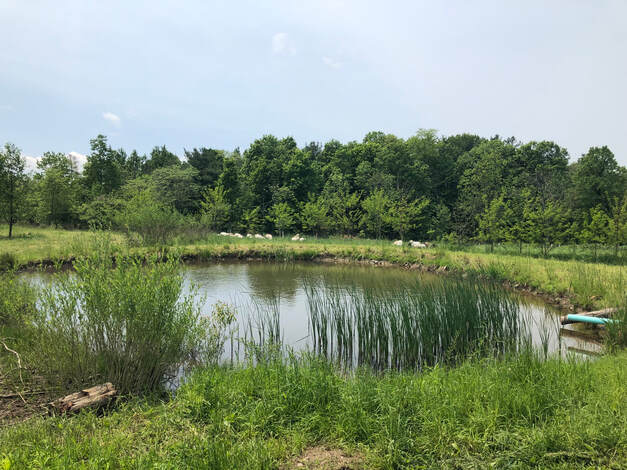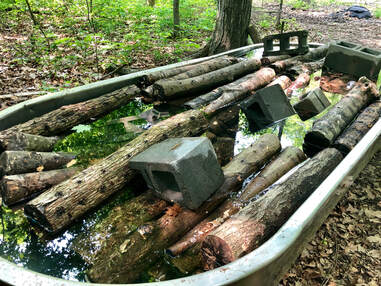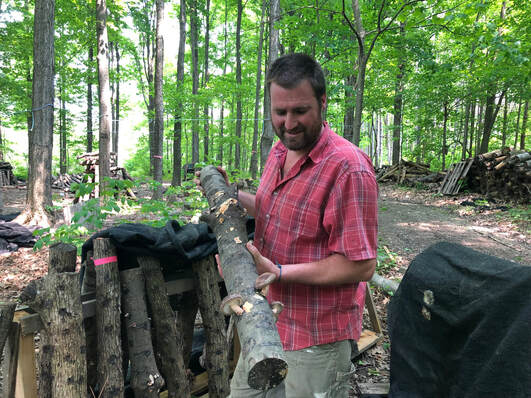Cornell University Permaculture Extension & Outreach

As permaculture permeates its way into academia, its scientific merit is rightfully questioned and the claims within are strengthened or discredited as a result. For several years, Steve Gabriel played a lead role in developing and teaching Cornell University’s permaculture programming, which included a for-credit student course (no longer offered) and three online Extension courses, entitled Permaculture: Fundamentals of Ecological Design (6.5 weeks), Permaculture Design: Ecosystem Mimicry (6.5 weeks), and Permaculture Design: Practicum (4.5 weeks). In interviewing Steve at his Wellspring Forest Farm in Mecklenburg, NY, I discovered his conflicted feelings about permaculture, and the unique lens it has provided for his work. He was one of the original co-founders of the Finger Lakes Permaculture Institute in 2005 and began working at Cornell in 2009 in the Department of Horticulture, focusing on permaculture and agroforestry research and education. He now runs the farm with his wife and is an agroforestry specialist for Cornell Extension’s small farms program.
Steve’s permaculture path began while studying at the University of Massachusetts, which supported him on a semester abroad in Scotland with the Findhorn Foundation Ecovillage. He became enamored by sustainable living and in returning to the U.S., took his PDC in the early 2000’s at Earthaven Ecovillage in North Carolina. After studying permaculture next in Oregon, Steve wound up in the Finger Lakes region of New York, where he experienced the struggles of running his own permaculture landscaping business and decided instead to hone in on farming, where he felt a more stable income could be found applying permaculture design. This is also which propelled him into Cornell Extension’s consumer horticulture program, at first editing lawn care fact sheets and working with the primarily retired, female audience of the state’s Master Gardener program. It didn’t take long for public interest in permaculture to begin pulling Steve and resulting in changes to the University’s Extension programming. “Part of my job when I first started was to go to every county Extension office and interview the community horticulture educator and basically get a sense of the state of horticulture in the state of New York. That’s 62 counties and I went to 58….out of that our program at the state level honed in on different theme areas each year as a way to enhance resources and improve enrollment. So the next year, the theme was compost and soil. For me, there was a lot of permaculture stuff I had learned that I could bring into that. And then the next year was about pollinator plants and polycultures or companion plants as it is often thought of in the garden world. That was the focus and so we did programming around that.” Regarding his training and experience in permaculture design, “people got super excited about it…[they] were always asking about it and I somehow got associated with it…that catapulted us to name permaculture.”
After funding ran out for Steve’s initial program development, “we had already started looking at online courses as a good way to generate revenue that didn’t require grants. My boss at the time proposed I develop a permaculture class and it just filled up. So it became the way I actually sustained the majority of my funding was through that course. With regards to enrollment, we were always shooting for about 20 in the first two – the fundamentals and the design and then there’s the practicum that always had less. 20, 20, and 10…We were just doing one of each of the three modules per year, now they are doing two of the introductory ones and one of each of the advanced courses because they were finding they could get 40 people into [the introductory one] and then you have attrition to the next level and then attrition to the next level.” When participants in the course complete all requirements, they are issued an approved permaculture design certificate through the Finger Lakes Permaculture Institute and Cornell University. Although they have seen enrollment from all over the world “Everyone in our online class was a hobby grower, or backyard gardener, or experimenter. It was not like, ‘I want to start a farm and make this a business.’”
 I asked Steve about the for-credit student course, how it was formed and what happened to it. He said, “it was both from curiosity of students and also my own interest in having a permaculture course in Cornell. What would that look like to offer that to students? And some students were interested. So, basically, the challenge with Cornell is they don’t really do adjunct faculty. They have tenure-track professors, you’ve got to be full PhD in the system, or you don’t really get to teach. But folks in the horticulture department at Cornell were flexible enough so we had an instructor of record…I basically did most of the teaching…We did the permaculture certification for students for four years…because the university wasn’t flexible enough to accommodate it, it was hard to sustain.” The for-credit course also underwent scrutiny from colleagues at the university. “There were memorable meetings in the educational curriculum committee about where [the content] came from…I tried to build out the curriculum more with reference-based work so that it brought more validity to it. But there was definitely pushback and concern.”
I asked Steve about the for-credit student course, how it was formed and what happened to it. He said, “it was both from curiosity of students and also my own interest in having a permaculture course in Cornell. What would that look like to offer that to students? And some students were interested. So, basically, the challenge with Cornell is they don’t really do adjunct faculty. They have tenure-track professors, you’ve got to be full PhD in the system, or you don’t really get to teach. But folks in the horticulture department at Cornell were flexible enough so we had an instructor of record…I basically did most of the teaching…We did the permaculture certification for students for four years…because the university wasn’t flexible enough to accommodate it, it was hard to sustain.” The for-credit course also underwent scrutiny from colleagues at the university. “There were memorable meetings in the educational curriculum committee about where [the content] came from…I tried to build out the curriculum more with reference-based work so that it brought more validity to it. But there was definitely pushback and concern.”
Around the same time, Steve’s work shifted into conducting mushroom research, and his programmatic area moved from consumer horticulture to agricultural Extension’s small farm program. This shift significantly altered Steve’s perception of and teaching in permaculture. “That was ultimately when I could see that permaculture…fell apart a little bit more when we started to look at the commercial aspects of land use production. Consumer horticulture felt much more comfortable in introducing these concepts and ideas…especially with an institution like Cornell it is very agricultural focused, back to the economics, back to the economics…Part of my transition has been to adopt and frame things more as agroforestry or agroecology. Because that has a much better foundation of research and most the folks in these fields are agronomists. They are in the interface between land and economics and that really lacks in permaculture. It was so much better received in consumer horticulture.”
Yet the whole systems design lens permaculture provides still permeates his work. “The projects I’m working on with mushroom cultivation are not just about producing thousands of pounds of mushrooms that people can sell, but the one in particular that we are working on has a lot of layers within urban agriculture and a lot of layers within racial and social justice and we are using mushrooms as this medium to work on those things which is really interesting. I’m actually with one little thing hitting more of my target of linking really important things that often feel disparate versus if I go into New York city and try to talk about permaculture it is hard to ground. So, we are grounding around this one thing, there’s a lot of opportunity to expand from there. I’m doing much more effective work doing than just permaculture.”
When I asked what he thought of the term “permaculture,” he said “I’m pretty allergic to it right now…I’m really conflicted by it because I’ve never seen anything that tries to stitch all those pieces together around living but at the same time I think, I know, that it’s very different in other parts of the world. In the U.S. it has become a white and male dominated thing and it has been very much used as a lever to prop people up into this weird fandom thing that we seem to do in the U.S. whether that’s a musician or a speaker.” He also has concerns with leaders in the permaculture movement not giving credit to various concepts where it is due, especially to the specific indigenous groups from which many techniques are pulled. He sees a critical need for increased self-reflection and to actively work toward truth and reconciliation efforts. Regardless, positive changes are happening in the U.S. “There’s a second wave now…there are people starting to dig more into the social angles and deficiencies of permaculture.”
Both within permaculture and the university system as a whole, Steve says major changes need to ensue. “The university seems more in many cases in the business of getting students to enroll and pay than they are in really preparing them for a career. Two years ago, there was a report that 60% of Cornell graduates across the university weren’t finding a job in their field in the first two years after graduation.” Despite his misgivings with the movement, permaculture design can provide a whole systems lens and practical application to enacting real-world change, empowering students and improving university operating structures.
Although permaculture could be strengthened with careful scrutiny and some needed changes, Steve’s definition of permaculture remains hopeful, which is “looking at sustainable or regenerative ways to live life…It’s a way to think about human habitats, how I live on the earth – not just in the food and the production-oriented stuff but the whole life cycle. All the things we have to do to survive and thrive are part of it.”
I agree that there are many positive ‘second waves’ of change in the permaculture movement – not just in the U.S. but globally as we turn our sites to solutions in the wake of climate change impacts and extreme stress to social structures. With academia housing many of its own issues, especially with cultivating practical skills and career preparedness, the potential of whole systems thinking, skills development, and resulting empowerment that permaculture can bring offers exciting potential. We just need to ensure the claims are credible, credited, and that we don’t lose site of the ethics that serve as the permaculture design framework core: earth care, people care, and fair share.
To discover more about Steve and Cornell University’s Permaculture Extension & Outreach programming, visit: https://onlinelearning.cornell.edu/permaculture-design-series and https://smallfarms.cornell.edu/about/staff/

Recent Posts

